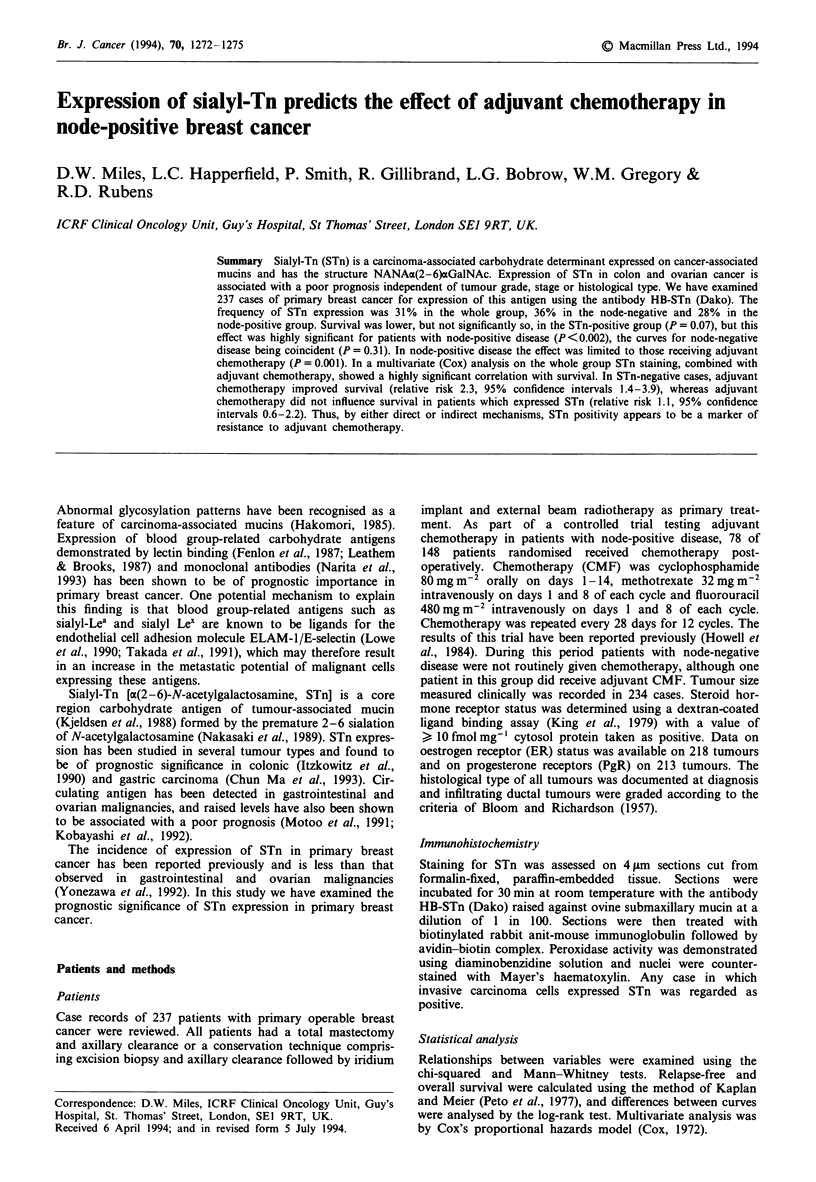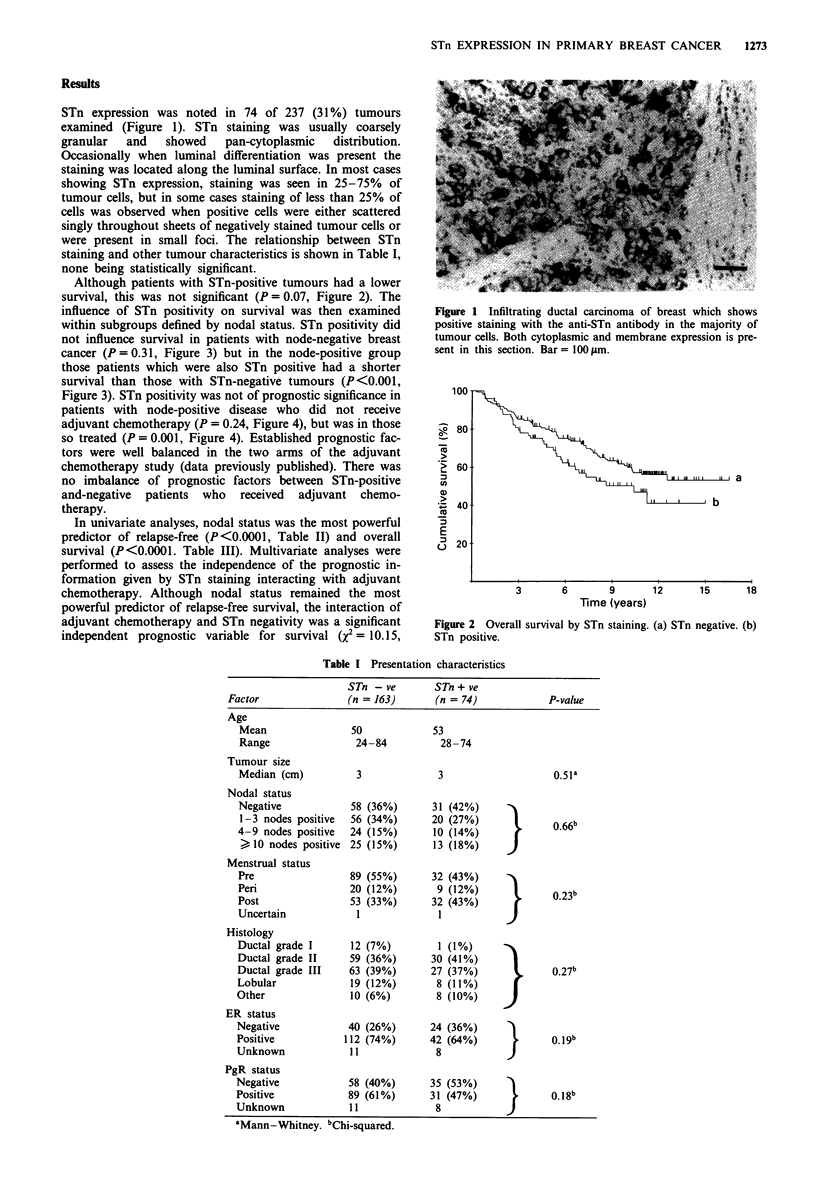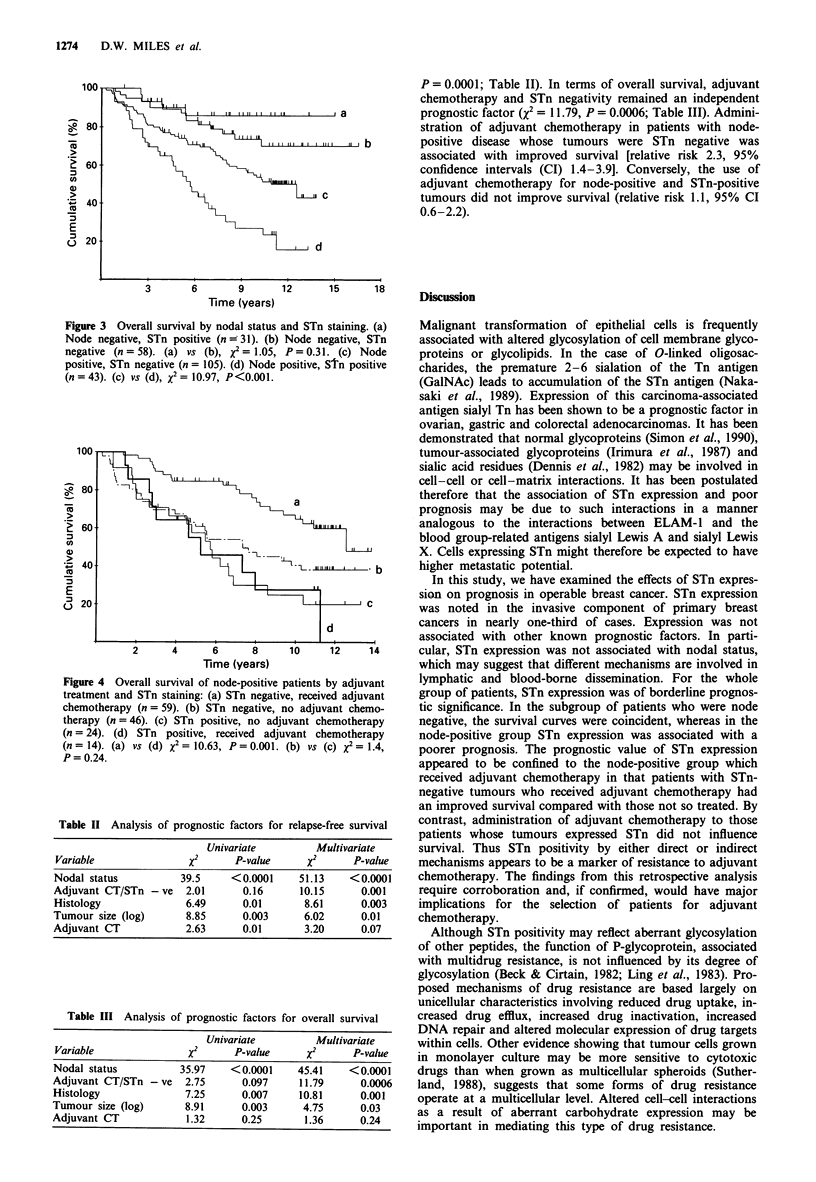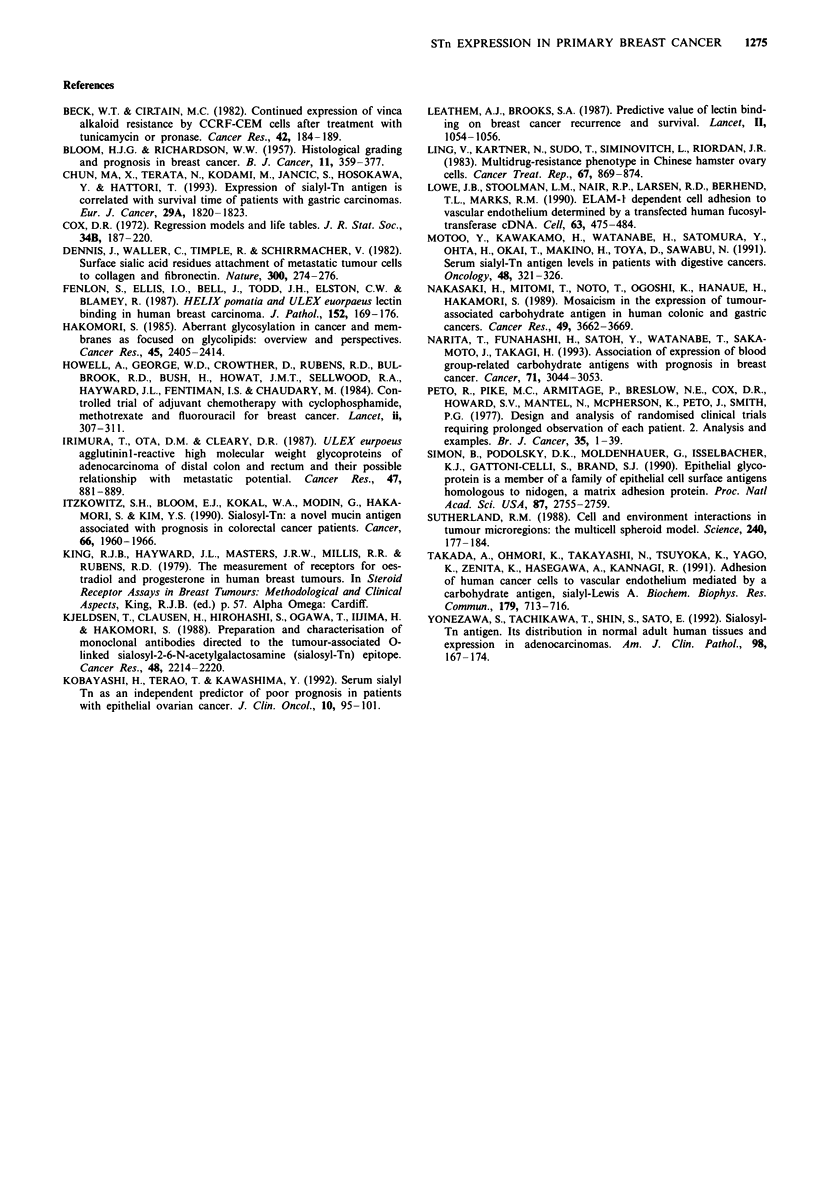Abstract
Sialyl-Tn (STn) is a carcinoma-associated carbohydrate determinant expressed on cancer-associated mucins and has the structure NANA alpha(2-6)alpha GalNAc. Expression of STn in colon and ovarian cancer is associated with a poor prognosis independent of tumour grade, stage or histological type. We have examined 237 cases of primary breast cancer for expression of this antigen using the antibody HB-STn (Dako). The frequency of STn expression was 31% in the whole group, 36% in the node-negative and 28% in the node-positive group. Survival was lower, but not significantly so, in the STn-positive group (P = 0.07), but this effect was highly significant for patients with node-positive disease (P < 0.002), the curves for node-negative disease being coincident (P = 0.31). In node-positive disease the effect was limited to those receiving adjuvant chemotherapy (P = 0.001). In a multivariate (Cox) analysis on the whole group STn staining, combined with adjuvant chemotherapy, showed a highly significant correlation with survival. In STn-negative cases, adjuvant chemotherapy improved survival (relative risk 2.3, 95% confidence intervals 1.4-3.9), whereas adjuvant chemotherapy did not influence survival in patients which expressed STn (relative risk 1.1, 95% confidence intervals 0.6-2.2). Thus, by either direct or indirect mechanisms, STn positivity appears to be a marker of resistance to adjuvant chemotherapy.
Full text
PDF



Images in this article
Selected References
These references are in PubMed. This may not be the complete list of references from this article.
- BLOOM H. J., RICHARDSON W. W. Histological grading and prognosis in breast cancer; a study of 1409 cases of which 359 have been followed for 15 years. Br J Cancer. 1957 Sep;11(3):359–377. doi: 10.1038/bjc.1957.43. [DOI] [PMC free article] [PubMed] [Google Scholar]
- Beck W. T., Cirtain M. C. Continued expression of vinca alkaloid resistance by CCRF-CEM cells after treatment with tunicamycin or pronase. Cancer Res. 1982 Jan;42(1):184–189. [PubMed] [Google Scholar]
- Dennis J., Waller C., Timpl R., Schirrmacher V. Surface sialic acid reduces attachment of metastatic tumour cells to collagen type IV and fibronectin. Nature. 1982 Nov 18;300(5889):274–276. doi: 10.1038/300274a0. [DOI] [PubMed] [Google Scholar]
- Fenlon S., Ellis I. O., Bell J., Todd J. H., Elston C. W., Blamey R. W. Helix pomatia and Ulex europeus lectin binding in human breast carcinoma. J Pathol. 1987 Jul;152(3):169–176. doi: 10.1002/path.1711520305. [DOI] [PubMed] [Google Scholar]
- Hakomori S. Aberrant glycosylation in cancer cell membranes as focused on glycolipids: overview and perspectives. Cancer Res. 1985 Jun;45(6):2405–2414. [PubMed] [Google Scholar]
- Howell A., Bush H., George W. D., Howat J. M., Crowther D., Sellwood R. A., Rubens R. D., Hayward J. L., Bulbrook R. D., Fentiman I. S. Controlled trial of adjuvant chemotherapy with cyclophosphamide, methotrexate, and fluorouracil for breast cancer. Lancet. 1984 Aug 11;2(8398):307–311. doi: 10.1016/s0140-6736(84)92684-9. [DOI] [PubMed] [Google Scholar]
- Irimura T., Ota D. M., Cleary K. R. Ulex europeus agglutinin I-reactive high molecular weight glycoproteins of adenocarcinoma of distal colon and rectum and their possible relationship with metastatic potential. Cancer Res. 1987 Feb 1;47(3):881–889. [PubMed] [Google Scholar]
- Itzkowitz S. H., Bloom E. J., Kokal W. A., Modin G., Hakomori S., Kim Y. S. Sialosyl-Tn. A novel mucin antigen associated with prognosis in colorectal cancer patients. Cancer. 1990 Nov 1;66(9):1960–1966. doi: 10.1002/1097-0142(19901101)66:9<1960::aid-cncr2820660919>3.0.co;2-x. [DOI] [PubMed] [Google Scholar]
- Kjeldsen T., Clausen H., Hirohashi S., Ogawa T., Iijima H., Hakomori S. Preparation and characterization of monoclonal antibodies directed to the tumor-associated O-linked sialosyl-2----6 alpha-N-acetylgalactosaminyl (sialosyl-Tn) epitope. Cancer Res. 1988 Apr 15;48(8):2214–2220. [PubMed] [Google Scholar]
- Kobayashi H., Terao T., Kawashima Y. Serum sialyl Tn as an independent predictor of poor prognosis in patients with epithelial ovarian cancer. J Clin Oncol. 1992 Jan;10(1):95–101. doi: 10.1200/JCO.1992.10.1.95. [DOI] [PubMed] [Google Scholar]
- Leathem A. J., Brooks S. A. Predictive value of lectin binding on breast-cancer recurrence and survival. Lancet. 1987 May 9;1(8541):1054–1056. doi: 10.1016/s0140-6736(87)90482-x. [DOI] [PubMed] [Google Scholar]
- Ling V., Kartner N., Sudo T., Siminovitch L., Riordan J. R. Multidrug-resistance phenotype in Chinese hamster ovary cells. Cancer Treat Rep. 1983 Oct;67(10):869–874. [PubMed] [Google Scholar]
- Lowe J. B., Stoolman L. M., Nair R. P., Larsen R. D., Berhend T. L., Marks R. M. ELAM-1--dependent cell adhesion to vascular endothelium determined by a transfected human fucosyltransferase cDNA. Cell. 1990 Nov 2;63(3):475–484. doi: 10.1016/0092-8674(90)90444-j. [DOI] [PubMed] [Google Scholar]
- Ma X. C., Terata N., Kodama M., Jancic S., Hosokawa Y., Hattori T. Expression of sialyl-Tn antigen is correlated with survival time of patients with gastric carcinomas. Eur J Cancer. 1993;29A(13):1820–1823. doi: 10.1016/0959-8049(93)90529-o. [DOI] [PubMed] [Google Scholar]
- Motoo Y., Kawakami H., Watanabe H., Satomura Y., Ohta H., Okai T., Makino H., Toya D., Sawabu N. Serum sialyl-Tn antigen levels in patients with digestive cancers. Oncology. 1991;48(4):321–326. doi: 10.1159/000226951. [DOI] [PubMed] [Google Scholar]
- Nakasaki H., Mitomi T., Noto T., Ogoshi K., Hanaue H., Tanaka Y., Makuuchi H., Clausen H., Hakomori S. Mosaicism in the expression of tumor-associated carbohydrate antigens in human colonic and gastric cancers. Cancer Res. 1989 Jul 1;49(13):3662–3669. [PubMed] [Google Scholar]
- Narita T., Funahashi H., Satoh Y., Watanabe T., Sakamoto J., Takagi H. Association of expression of blood group-related carbohydrate antigens with prognosis in breast cancer. Cancer. 1993 May 15;71(10):3044–3053. doi: 10.1002/1097-0142(19930515)71:10<3044::aid-cncr2820711026>3.0.co;2-r. [DOI] [PubMed] [Google Scholar]
- Peto R., Pike M. C., Armitage P., Breslow N. E., Cox D. R., Howard S. V., Mantel N., McPherson K., Peto J., Smith P. G. Design and analysis of randomized clinical trials requiring prolonged observation of each patient. II. analysis and examples. Br J Cancer. 1977 Jan;35(1):1–39. doi: 10.1038/bjc.1977.1. [DOI] [PMC free article] [PubMed] [Google Scholar]
- Simon B., Podolsky D. K., Moldenhauer G., Isselbacher K. J., Gattoni-Celli S., Brand S. J. Epithelial glycoprotein is a member of a family of epithelial cell surface antigens homologous to nidogen, a matrix adhesion protein. Proc Natl Acad Sci U S A. 1990 Apr;87(7):2755–2759. doi: 10.1073/pnas.87.7.2755. [DOI] [PMC free article] [PubMed] [Google Scholar]
- Sutherland R. M. Cell and environment interactions in tumor microregions: the multicell spheroid model. Science. 1988 Apr 8;240(4849):177–184. doi: 10.1126/science.2451290. [DOI] [PubMed] [Google Scholar]
- Takada A., Ohmori K., Takahashi N., Tsuyuoka K., Yago A., Zenita K., Hasegawa A., Kannagi R. Adhesion of human cancer cells to vascular endothelium mediated by a carbohydrate antigen, sialyl Lewis A. Biochem Biophys Res Commun. 1991 Sep 16;179(2):713–719. doi: 10.1016/0006-291x(91)91875-d. [DOI] [PubMed] [Google Scholar]
- Yonezawa S., Tachikawa T., Shin S., Sato E. Sialosyl-Tn antigen. Its distribution in normal human tissues and expression in adenocarcinomas. Am J Clin Pathol. 1992 Aug;98(2):167–174. doi: 10.1093/ajcp/98.2.167. [DOI] [PubMed] [Google Scholar]



